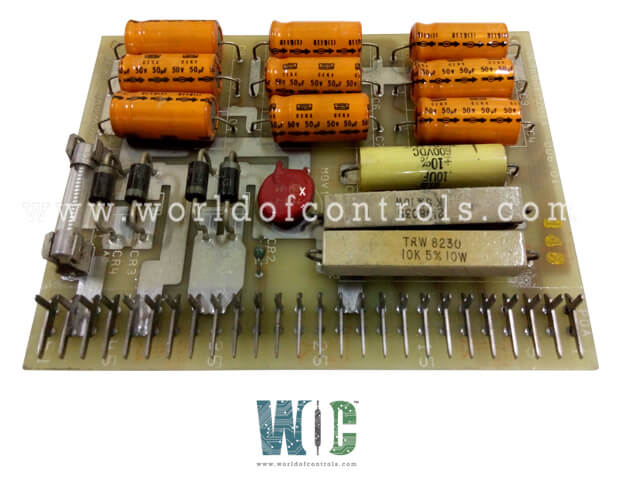SPECIFICATIONS
Part No.: IC3600EPSX1D1B
Manufacturer: General Electric
Country of Manufacture: United States of America (USA)
Product Type: Voltage Regulator Board
Availability: In Stock
Series: VersaMax
Functional Description
IC3600EPSX1D1B is a Voltage Regulator Board. It is a part of GE Mark I and II control series. This board functions as a -12V DC to DC converter, converting unregulated DC input into a stable and regulated -12V output. Its primary role is to ensure that voltage remains consistent, which is crucial for various industrial control applications, particularly in turbine systems.
Features
- The board effectively receives unregulated DC input from an inverter power supply and converts it into a stable -12V output through a series regulation process. This capability is essential for maintaining voltage stability in control processes.
- The design includes short circuit protection and allows for the parallel operation of up to eight supplies, providing scalability and flexibility to meet the demands of larger systems.
- The board is composed of three distinct circuits that enhance its functionality. Regulator Circuit uses an integrated voltage regulator equipped with its own reference and error amplifier, ensuring precise regulation of the output voltage at -12V. Parallel Circuit Facilitates the parallel operation of multiple boards, which is vital for managing higher loads and ensuring balanced distribution of power across connected devices. Current Limit Circuit permits a maximum output current of 1 ampere, with a built-in foldback feature that reduces output current and voltage if demand exceeds 1.2 amperes, thereby protecting the board from potential damage.
Detailed Circuit Functionality
- The regulator circuit employs an integrated circuit (IC1) to monitor the output voltage continually. If the output attempts to drop below -12V, the inverting input of IC1 detects this change and adjusts the output accordingly.
- Key components like transistors Q6, Q13, and Q14 play a crucial role in managing base drive current, thereby regulating the output effectively. Two resistor bridges in the circuit help stabilize both the reference voltage and output voltage.
- The parallel circuit allows for the connection of up to eight modules, promoting a cooperative operation that enhances system reliability.
- This circuit comprises a current source and a switching transistor (Q8), which works in conjunction with an analog control transistor (Q9). This arrangement ensures that the module with the highest voltage draws the least current, thus minimizing voltage drop and maintaining a stable -12V output across all units.
- The current limit circuit is configured to handle up to 1 ampere under normal conditions. If the output load exceeds 1.2 amperes, the circuit triggers a foldback mechanism, effectively reducing both output current and voltage to safeguard the module.
- Additionally, the -12V supply is safeguarded by diodes that prevent reverse polarity, further ensuring the integrity and stability of the output.
Inputs and Outputs
Inputs:
- It requires N12X and VM (-12V) for its operation, with N12X providing the necessary output power.
- VM (+12V) serves as the control power source for the regulator.
- The board operates within a voltage range of 17V at full load to -19V at 0.5 amperes, with no-load voltage reaching -32.7V.
Outputs:
- The primary output is a negative 12V supply, capable of delivering up to 1 ampere with excellent voltage regulation (+0.25%) under varying load conditions, and 5% regulation over a range of temperatures.
- The board also supports remote sensing, achieved by connecting +VS and SCOM to the load, utilizing a twisted, shielded pair to minimize interference and ensure stable operation.
The current limit feature is set to initiate foldback at approximately 1.2 amperes, providing an additional layer of protection against overcurrent conditions.
The WOC team is always available to help you with your Mark I and II requirements. For more information, please contact WOC.
Frequently Asked Questions
What is IC3600EPSX1D1B?
It is a Voltage Regulator Board developed by GE under the Mark I and II series.
What type of input does the Board require?
The board requires unregulated DC inputs of N12X and VM (-12V). N12X provides the necessary output power, while VM (+12V) supplies control power for the regulator.
How does the voltage regulation work on this board?
It uses an integrated voltage regulator that includes its own reference and error amplifier. It monitors the output voltage, and if it deviates from -12V, the regulator adjusts the output to maintain stability. This is accomplished through a feedback mechanism involving transistors that regulate base drive current.
Can multiple boards be used together?
Yes, the board allows for parallel operation with up to eight units. This feature promotes load balancing and scalability, enabling systems to handle larger power demands effectively.
What happens if the output load exceeds the board's rated capacity?
The current limit circuit is designed to allow up to 1 ampere of output current under normal conditions. If the load exceeds 1.2 amperes, a foldback mechanism reduces both the output current and voltage to protect the board from potential damage.
How is remote sensing achieved?
Remote sensing is accomplished by connecting the +VS and SCOM terminals to the load using a twisted, shielded pair. This configuration helps to minimize interference and ensures stable voltage delivery to the load.
